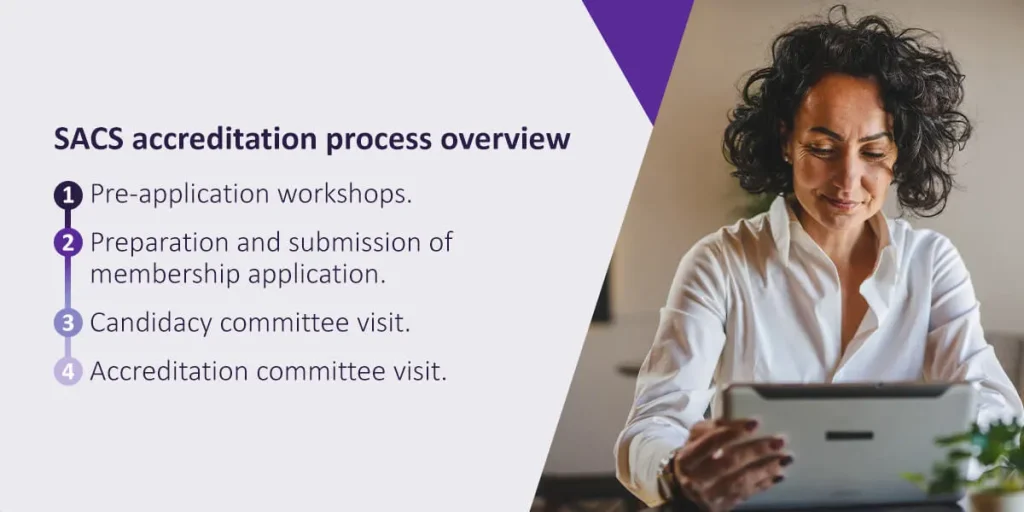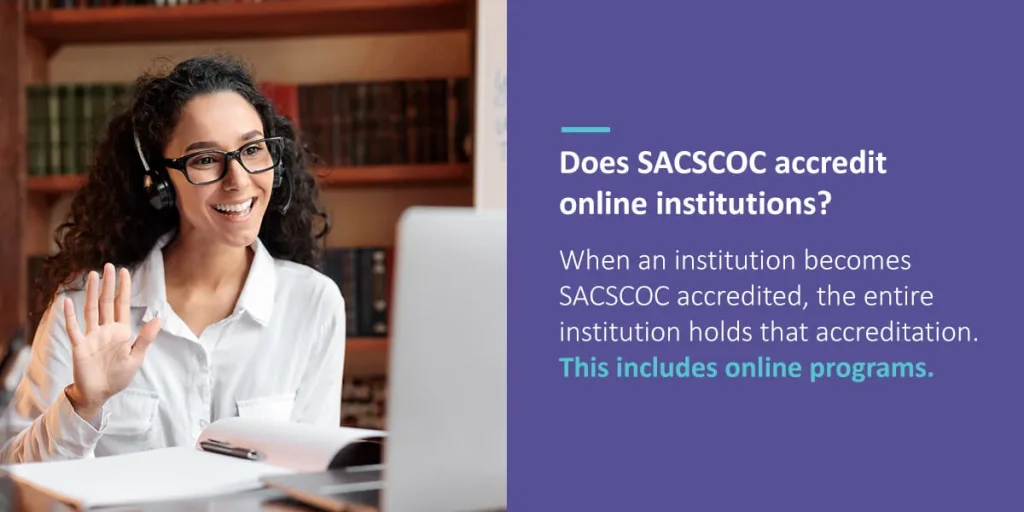




The Southern Association of Colleges and Schools Commission on Colleges (SACSCOC) is a commission dedicated to higher education in the southern region of the United States and American schools in Mexico, Central America, the Caribbean Sea, and South America. It has jurisdiction over thousands of schools and is recognized by both the Council for Higher Educational Accreditation (CHEA) and the U.S. Department of Education (DOE).
Accreditation indicates that an institution meets and exceeds quality standards and is committed to continuous improvement. Having a respected association like SACS extend accreditation to your college or university speaks to the standards upheld by your institution and your dedication to providing the best educational experience for your students.
The Southern Association of Colleges and Schools (SACS) grants accreditation to higher education institutions that meet the educational standards set by the SACSCOC. This commission is the accreditation body of degree-granting institutions within the jurisdiction.
Having SACS accreditation signifies the following about a higher education institution:
Colleges and universities must be eligible and meet the criteria set forth by SACSCOC’s standards to receive accreditation. They must meet the prerequisites, provide the necessary documentation, and apply.
To be eligible for SACS accreditation, a higher-education institution must be degree-granting and located in one of the following states in the U.S.:
The association also evaluates U.S. schools located in Latin America.
In addition, the institution needs to comply with the standards noted in the Principles of Accreditation: Foundations for Quality Enhancement. In this resource, you can learn more about SACSCOC and its requirements. The SACSCOC Board of Trustees assesses each school and makes accreditation decisions using this document.

Obtaining accreditation from SACSCOC requires following a procedure that includes four phases. The following outlines the process:
Before becoming eligible to apply for membership, prospective applicants must partake in two different virtual events — the Pre-Applicant Institutional Effectiveness Workshop and the Pre-Applicant Workshop.
Each workshop has two parts. The first is for watching slide presentations, and the second is a conference call where prospective applicants can discuss and address questions. Institutions can register only two people to participate in these workshops. There is a fee per participant for each workshop.
The next phase is for preparing the Application for Membership document. On average, preparing the application requires anywhere from several months to a couple of years. SACSCOC shares additional information and documents to help applicants gather their information and prepare their forms.
When preparing the application, SACS accreditation standards require applicants to submit a Compliance Certification report. The report must include documentation and supportive evidence demonstrating your institution’s compliance with SACSCOC standards. For example, a significant factor considered is an institution’s faculty credentials. Your faculty’s degrees establish their credibility as experts in their fields, and the Association accounts for this when reviewing your application. Other evidence you may need to provide includes general education requirements, learning resources, student support, and statements from your governing board.
The application itself is just under 40 pages long with submission instructions, and the applicant must also provide an application fee at the time of submission.
Next, a Candidacy Committee visit occurs if the applicant successfully fills out the membership application and meets all standards. The Candidacy Committee travels to an institution’s main campus and off-campus sites at the institution’s cost. During the visit, the Committee aims to verify the information that was in your Compliance Certification report. They’ll likely interview faculty and students, tour your facilities, view course content, and may request additional documentation.
With the information accrued from the visits, the Committee creates a detailed report. They’ll use their visit report to recommend candidacy to the Board of Trustees. The Candidacy Committee only makes candidacy recommendations based on their findings, and the Board makes the final decisions. After receiving the recommendation, the Board reviews these reports during one of two meetings in June or December. Using this report, the Board will deny or grant Candidacy status.
Candidacy doesn’t equate to accreditation. If an institution is granted candidacy, it simply means they’ve met the basic requirements and are eligible for further review.
If the Board of Trustees bestows Candidacy onto a school, the next step is a visit from the Accreditation Committee. Like the Candidacy Committee, the Accreditation Committee will visit the main campus and any additional off-campus instructional sites at the institution’s expense. They’ll create their own report based on their findings, which the SACSCOC Board will also review in either June or December at their meeting. With their report, the Accreditation Committee recommends whether the institution should be granted accreditation.
The Board considers all this and is the ultimate decision-maker. The Board can agree or disagree with the Committees’ recommendations and either grants or denies accreditation. If the Board of Trustees grants accreditation, it is good for five years before needing reaffirmation.
In addition to Candidacy Committee reviews of potential candidates and Accreditation Committee reviews of institutions seeking membership, the SACSCOC Board of Trustees performs reviews for a few additional reasons after granting accreditation, including the following:
The reaffirmation process involves two main phases. The first phase is preparation by the institution. Members must complete and submit the Compliance Certification 15 months before the scheduled affirmation. Six weeks in advance of the On-Site Reaffirmation Review Committee, members must submit their quality enhancement plan (QEP). The QEP describes how an institution plans to enhance student success and learning and address related issues. Rather than analyze past and current procedures, this report outlines how the institution will continue to improve over the next accreditation period.
For the second phase, the Commission on Colleges has committees conduct off-site and on-site reaffirmation reviews, followed by a review from the SACSCOC Board of Trustees. The Association shares final decisions at the annual business session in December.
SACSCOC accreditation can be challenging to understand, especially when undergoing the process for the first time. Here are the answers to a few more questions you may have.
Failure to meet SACSCOC standards can result in denial of accreditation or reaffirmation. In less severe cases, SACSCOC may request monitoring reports to demonstrate the institution’s attempt to comply with the standards. Institutions can also be issued warnings or placed on probation until they meet SACSCOC standards.
SACSCOC-accredited institutions should provide an accreditation statement in their handbook or catalog. SACSCOC requires institutions to disclose their accreditation status publicly, whether that status is in process, granted, or on probation. You can also search for accredited institutions on the SACSCOC website.
Overall, SACSCOC considers institutional integrity, commitment to quality enhancement, and student learning outcomes. They want to see qualified faculty that can properly teach the curriculum, a QEP that indicates a dedication to improvement, and financial health to ensure the institution has the necessary resources to support its educational programs.

When an institution becomes SACSCOC accredited, the entire institution holds that accreditation. This includes online programs, off-campus learning sites, branch campuses, and any other distance learning programs. Many institutions offer a variety of traditional, in-person, and online courses or programs that would fall under the institution’s broader SACSCOC accreditation. It’s best to check with the institution itself.

We designed Watermark Planning & Self-Study to make life easier for higher education institutions. It centralizes all your strategic plans, goals, and assessments to create a streamlined, repeatable process that keeps everyone on the same page. Just some of the benefits of this award-winning software include:
With over 20 years of experience helping thousands of colleges and universities, we can empower your institution to look beyond the numbers and create and support meaningful practices.
Our higher education software supports continuous improvement, with several solutions spanning from Planning & Self-Study to Watermark Course Evaluations & Surveys. We can help your institution gather, share, and obtain insights from your data to drive your mission.
Want to learn more about what we can do for your institution? Request a demo today!































































































































































































































































































































































































Submit this form to schedule a meeting with one of our reps to learn more about our solutions. If you need customer support instead, click here.